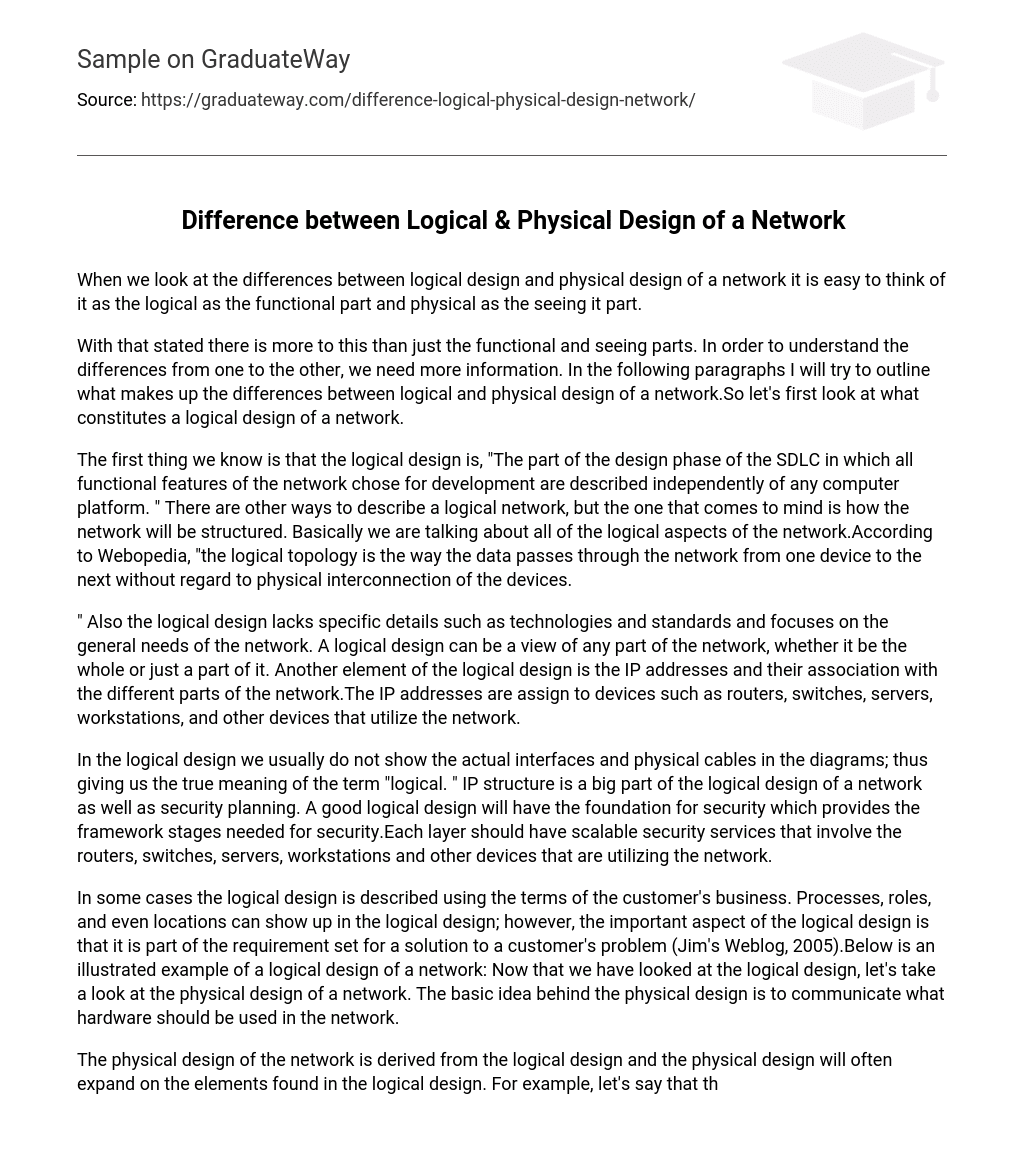When we look at the differences between logical design and physical design of a network it is easy to think of it as the logical as the functional part and physical as the seeing it part.
With that stated there is more to this than just the functional and seeing parts. In order to understand the differences from one to the other, we need more information. In the following paragraphs I will try to outline what makes up the differences between logical and physical design of a network.So let’s first look at what constitutes a logical design of a network.
The first thing we know is that the logical design is, “The part of the design phase of the SDLC in which all functional features of the network chose for development are described independently of any computer platform. ” There are other ways to describe a logical network, but the one that comes to mind is how the network will be structured. Basically we are talking about all of the logical aspects of the network.According to Webopedia, “the logical topology is the way the data passes through the network from one device to the next without regard to physical interconnection of the devices.
” Also the logical design lacks specific details such as technologies and standards and focuses on the general needs of the network. A logical design can be a view of any part of the network, whether it be the whole or just a part of it. Another element of the logical design is the IP addresses and their association with the different parts of the network.The IP addresses are assign to devices such as routers, switches, servers, workstations, and other devices that utilize the network.
In the logical design we usually do not show the actual interfaces and physical cables in the diagrams; thus giving us the true meaning of the term “logical. ” IP structure is a big part of the logical design of a network as well as security planning. A good logical design will have the foundation for security which provides the framework stages needed for security.Each layer should have scalable security services that involve the routers, switches, servers, workstations and other devices that are utilizing the network.
In some cases the logical design is described using the terms of the customer’s business. Processes, roles, and even locations can show up in the logical design; however, the important aspect of the logical design is that it is part of the requirement set for a solution to a customer’s problem (Jim’s Weblog, 2005).Below is an illustrated example of a logical design of a network: Now that we have looked at the logical design, let’s take a look at the physical design of a network. The basic idea behind the physical design is to communicate what hardware should be used in the network.
The physical design of the network is derived from the logical design and the physical design will often expand on the elements found in the logical design. For example, let’s say that the logical design shows a WAN connection as line between to buildings.When this is transformed into a physical design, that single line could expand into the connection, routers and other equipment at each end of the connection (Jim’s Weblog, 2005). The physical design also involves the specific technologies and products that are realized from the logical design.
This involves the actual devices that will be used to get the logical design to work. The physical design also will involve the topology that will be used in the network.The physical topologies vary and there are many to choose from such as the Ring topology, the Bus topology, the Star topology, the Mesh and many others depending on the needs of the customer. A Ring topology would be: All devices are connected to one another in the shape of a closed loop, so that each device is connected directly to two other devices, one on either side of it (Webopedia, 2006).
A Bus topology would be: All devices are connected to a central cable, called the bus or backbone. Bus networks are relatively inexpensive and easy to install for small networks.Ethernet systems use a bus topology. A Star topology would be: All devices are connected to a central hub.
Star networks are relatively easy to install and manage, but bottlenecks can occur because all data must pass through the hub (Webopedia, 2006). So when we refer to the physical design we are talking about the actual physical layout of the network. This includes the cables, switches, workstations, routers, and servers. The physical design involves a diagram of the actual way the network will be seen.
Below is an illustrated example of the physical design of a network:In conclusion, the difference between logical design and physical design of a network is in the way they are presented. The logical being the one that shows how the data flows and the physical showing the devices and connections of the network. You can think of logical and physical as like cars and roads. The roads represent the physical network where each road is interconnected and the cars represent the logical where when they move towards a certain destination within the network.
Although logical and physical networks vary, they still work together to better define the same network.





